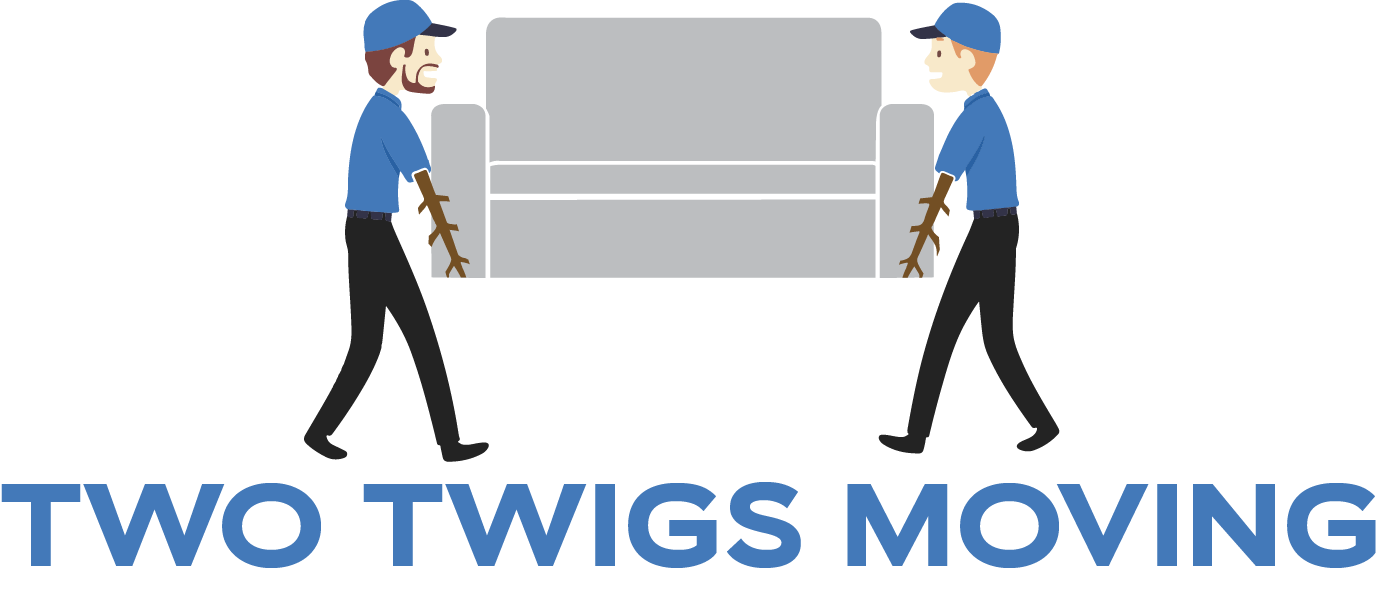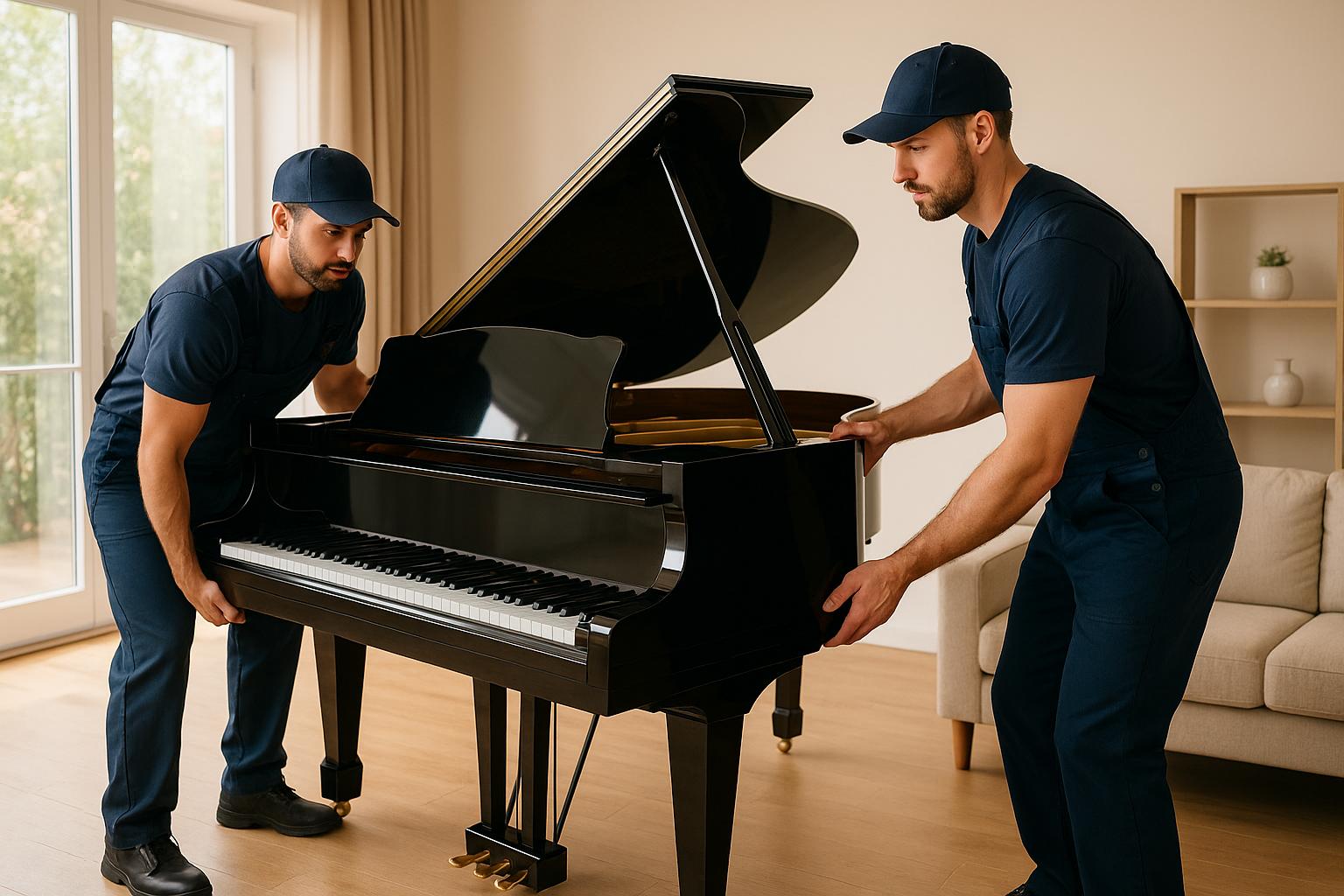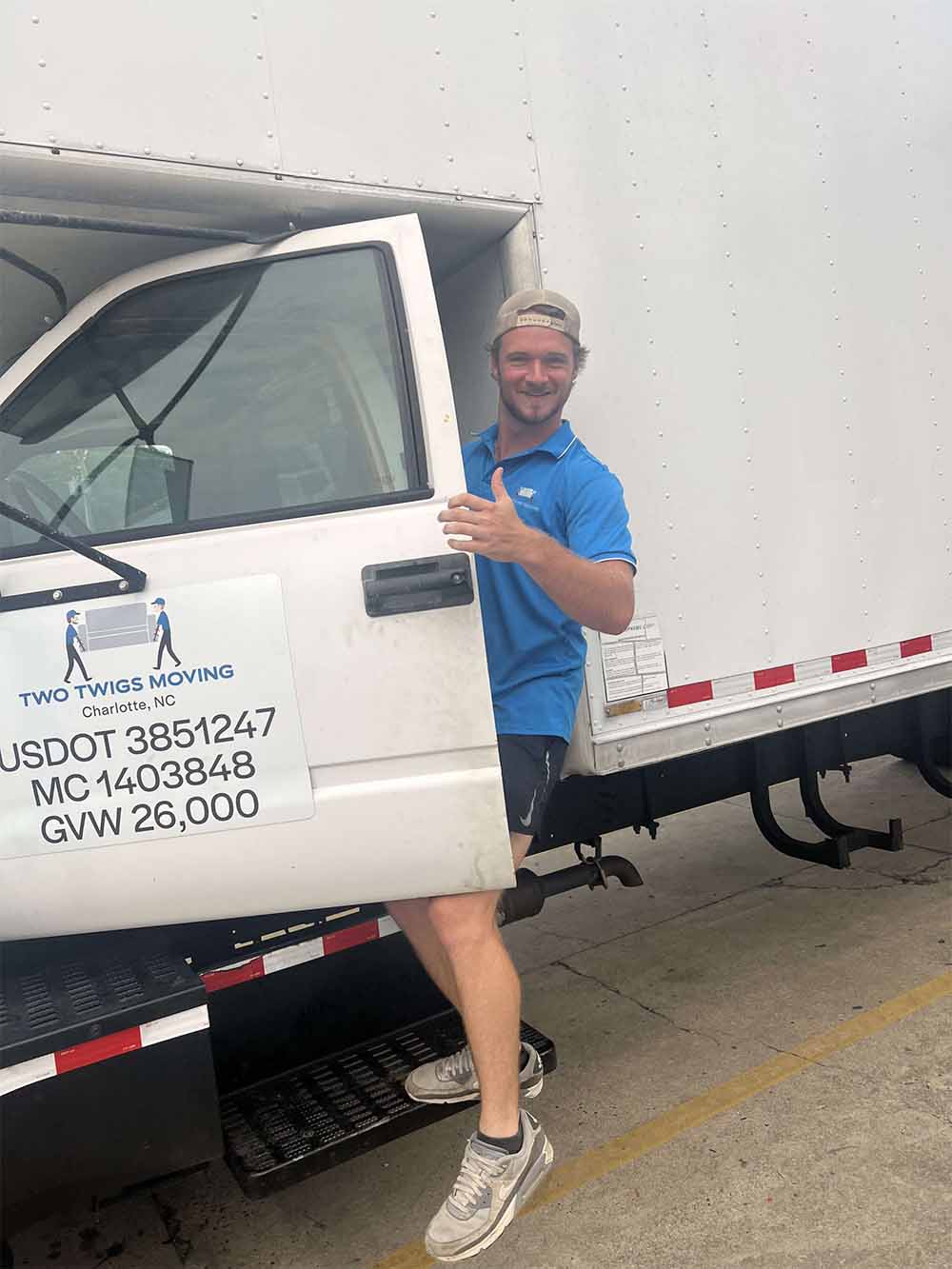Moving a piano is a daunting task that requires precision, planning, and the right tools. Mistakes can lead to costly repairs, injuries, or damage to your home. Here are the five key errors to avoid:
- DIY Moves Without Professionals: Pianos are heavy and delicate. Attempting to move one without expertise risks injuries, property damage, and harm to the piano itself. Professional movers have the skills, tools, and insurance to handle this safely.
- Using Improper Equipment: Relying on standard dollies or the piano’s casters can result in accidents. Specialized tools like piano dollies, straps, and padding are crucial for safe transport.
- Skipping Measurements and Planning: Failing to measure doorways, hallways, and staircases can lead to delays or damage. Plan your route in advance to avoid tight spots.
- Not Securing the Piano During Transit: An unsecured piano can shift during transport, leading to internal damage or scratches. Proper padding, straps, and careful positioning are essential.
- Neglecting Post-Move Care: After moving, give the piano time to settle before tuning. Environmental changes during the move can impact its sound and structure.
Quick Tip: Hiring professional movers, like Two Twigs Moving in Charlotte, Charleston, or Greenville, can save you time, money, and stress. Their expertise ensures your piano arrives safely and in perfect condition.
Attempting a DIY Move Without Professional Help
Trying to move a piano on your own might seem like a way to save money, but it comes with serious risks – both to your health and your wallet.
The Risks of DIY Piano Moving
Injuries are one of the biggest dangers. Pianos can weigh anywhere from 300 to 1,300 pounds, and without proper lifting techniques, you could end up with muscle strains, herniated discs, or even spinal injuries . Worse, if the piano tips or falls during transport, it can cause significant harm to anyone nearby.
The financial risks are just as concerning. Pianos are intricate instruments with thousands of delicate parts, and inexperienced handling can lead to damage like chipped edges, broken legs, or malfunctioning pedals .
Then there’s the potential for property damage. Navigating a piano through tight spaces – like doorways, staircases, or narrow hallways – can easily scratch walls, dent floors, or damage door frames. This could mean costly repairs or even losing your security deposit if you’re renting.
Environmental factors also play a role. Improper handling in fluctuating temperatures or high humidity can disrupt the piano’s internal mechanisms, leading to retuning costs that typically range between $150 and $300.
When you weigh these risks, hiring professionals isn’t just safer – it’s often the smarter financial choice.
The Value of Professional Movers
As mentioned earlier, moving a piano is no ordinary task. It requires specialized skills and tools, and that’s where professional movers shine. They’re trained to handle instruments with over 12,000 intricate parts – like strings, hammers, and other delicate components – ensuring everything stays intact. They also know how to safely maneuver through tricky spaces like staircases and narrow doorways .
Professionals come equipped with tools designed specifically for piano moves, including dollies, straps, and padded blankets . These tools, combined with their expertise, minimize the risk of damage during transport.
Another big advantage? Insurance. Most professional movers offer insurance coverage, so if something does go wrong, your piano is protected .
Hiring experts also saves time. They can complete the move much faster than an untrained person and know how to safeguard your piano against environmental factors that might affect its tuning .
If you’re in Charlotte, Charleston, or Greenville, Two Twigs Moving offers specialized piano moving services. Their team of trained, background-checked professionals uses the right equipment and techniques to ensure your piano arrives in perfect condition. Choosing their services not only protects your piano but also ensures your peace of mind.
Using Wrong Equipment or Techniques
Moving a piano is no small task, and using the wrong tools or techniques can lead to expensive damage – not just to the instrument but also to your home. That’s why it’s crucial to address these risks with the right equipment and methods, as discussed earlier.
Common Equipment Mistakes
One of the most common errors is relying on the piano’s casters for movement. Upright piano casters are primarily decorative and not built to handle the instrument’s full weight. This can lead to breakage or even tipping over .
Another frequent mistake is using standard moving dollies instead of equipment designed specifically for pianos. Regular dollies can’t handle the piano’s unique weight distribution and bulk, which increases the risk of accidents. The piano might slide off or the dolly could collapse under the weight.
Skipping proper padding is another major oversight. Without sufficient padding, a piano is vulnerable to scratches, scuffs, and dents during the move. Even minor bumps against walls or door frames can damage the finish.
Improper lifting techniques are also a common problem. Lifting a piano incorrectly can cause structural damage, such as cracks in the frame or soundboard, and can even lead to tuning issues. On top of that, it poses a serious risk of personal injury. Repairs for these issues aren’t cheap – fixing a cracked soundboard can cost over $1,000, while repairs to the action mechanism might range from $500 to $2,000, depending on the extent of the damage.
These challenges highlight the importance of using purpose-built equipment, which brings us to the tools designed specifically for safe piano moving.
Why You Need Specialized Tools
Specialized tools are essential for safely moving a piano. Not only do they protect the instrument, but they also make the process more efficient and reduce the risk of costly repairs. For example, piano dollies and skid boards are designed to handle the unique weight distribution of pianos. Unlike standard dollies, piano dollies are built to support the instrument’s bulk. The proper method often involves removing the piano legs and using a four-wheel piano dolly to transport the main body.
Heavy-duty straps and protective padding are also crucial. These tools are specifically engineered to secure pianos weighing anywhere from 300 to 1,200 pounds. Padding acts as a protective barrier, shielding the piano from impacts during transit.
Professional movers bring expertise to the table, navigating tight spaces like narrow staircases and uneven surfaces without causing damage. They know how to evenly distribute the piano’s weight, maintain control throughout the move, and work as a coordinated team to ensure everything goes smoothly.
Using the right tools not only enhances safety but also makes the moving process faster and more manageable . When you consider the potential costs of repair or medical bills from injuries, investing in specialized equipment and techniques is a financially sound decision.
For those moving in Charlotte, Charleston, or Greenville, Two Twigs Moving offers professional piano moving services. Their team uses high-quality piano dollies, protective padding, and proven methods to ensure your piano arrives at its destination without a scratch – avoiding the costly mistakes outlined here.
Failing to Plan and Measure Properly
When it comes to moving a piano, even the most advanced equipment won’t save you from trouble if you skip proper planning. Overlooking the importance of measuring and route planning can lead to costly mistakes, delays, and unnecessary headaches. Here’s how to avoid these pitfalls.
Measuring and Route Planning
Start by measuring your piano and all access points – this includes doorways, hallways, and stairwells. Be thorough and check dimensions at both your current location and your destination. Pay attention to any potential obstacles like furniture, rugs, or architectural features that might reduce clearance.
Before moving day, clear the route by relocating anything in the way and, if needed, add protective coverings such as cardboard to safeguard floors. If tight spots are unavoidable, consider removing doors or disassembling parts of the piano to create more space. When maneuvering through narrow corners, angling the piano diagonally on the dolly can make all the difference. If the piano simply doesn’t fit through a doorway, don’t force it – disassemble parts if possible or rethink your route. These small but precise adjustments can prevent big problems.
Communicate all these details with your moving team ahead of time. Professional movers, like those in Charlotte, Charleston, and Greenville, are well-versed in handling these challenges. Their experience ensures that potential issues are addressed before they even arise.
Problems from Poor Planning
Skipping proper planning can result in unexpected complications, delays, and even damage to your piano. Poor route planning – such as ignoring doorway widths or failing to account for obstacles – can lead to the piano getting stuck in tight spaces. This often results in unnecessary lifting, repositioning, and sometimes even damage to walls, door frames, or drywall. Forcing a piano through a narrow space can also harm its finish, crack its frame, or cause internal issues that impact its sound quality.
Time delays are another major issue. What should be a straightforward move can stretch into hours of frustration without proper preparation. Since professional movers typically charge by the hour, these delays can significantly increase your costs. In worst-case scenarios, you might need additional help or specialized equipment, adding to the expense.
To avoid these problems, double-check all doorways, hallways, and stairs along the route. Investing time in careful measuring and planning can save you from hours of stress and potentially expensive repairs.
For those in Charlotte, Charleston, and Greenville, Two Twigs Moving offers a professional piano moving service that includes comprehensive measuring and route planning. Their expertise ensures a smooth move, addressing potential challenges before they escalate into problems.
sbb-itb-a5538b6
Not Securing or Protecting the Piano During Transit
Once you’ve carefully planned and measured everything, the next big step is making sure the piano is secure during transit. Properly securing the piano is absolutely essential. Even if you’ve loaded it with care, failing to secure it can lead to serious trouble. An unsecured piano can shift unexpectedly during transport, potentially causing significant damage – not just to the piano itself but also to other items around it.
How to Secure the Piano Properly
Safe piano transport starts with smart positioning and thorough protection. Begin by wrapping the entire piano in thick moving blankets, making sure to secure them with stretch wrap. Avoid taping directly onto the piano’s finish – this can cause damage. When loading the piano into the truck, position it snugly against a wall. For upright pianos, place the keyboard side against the wall. For grand pianos, the straight (keyboard) edge should face the wall, with the curved side facing outward.
"Use the right equipment, keep the piano snugly tied down, and cushion every surface." – Mina Georgalas, Owner of Bernard Movers
Next, fasten the piano in place using two heavy-duty ratchet straps. Anchor these straps at different heights, and use protective pads wherever the straps touch the piano to prevent marks or damage. Add corner protectors to safeguard the edges. If the upright piano is left on a dolly, remember to lock the dolly wheels and make sure the truck floor is level. For proper weight distribution, place heavier items – like the piano – toward the front of the truck. Before hitting the road, double-check all straps and padding to ensure nothing can shift. Lastly, avoid exposing the piano to extreme temperatures or moisture during the move. Following these steps, combined with careful planning and the right tools, helps ensure a safe, damage-free move.
What Happens with Poor Transit Protection
Neglecting these safety measures can turn your piano into a major hazard. Weighing anywhere between 300 and 1,400 pounds, an unsecured piano can shift during transport, leading to serious damage. Its intricate internal mechanisms – like strings, hammers, and the soundboard – are particularly vulnerable. Damage to these parts can impact sound quality and playability, often requiring costly repairs. Poor padding or loose straps can also result in cosmetic issues, such as scratches, dents, or damage to the finish, which can lower the piano’s value and visual appeal. Upright pianos, with their tall and narrow design, are especially prone to tipping, while grand pianos, though more stable when disassembled and placed on a skid board, can still slide if not properly secured.
If you’re in Charlotte, Charleston, or Greenville, Two Twigs Moving provides expert piano moving services. Their team is equipped with the right tools and techniques to secure and protect your piano throughout the entire process, ensuring it arrives at its destination in perfect condition. With their help, you can avoid the risks that come with improper transit protection.
Skipping Post-Move Care and Tuning
Once your piano has made it safely to its new home, the journey isn’t quite over. While you might be eager to start playing, taking the time for proper post-move care is crucial. The vibrations, temperature changes, and handling during transport can subtly impact your piano’s internal components, even if everything looks fine on the surface.
Why Post-Move Care Matters
Moving a piano is a delicate process that can affect its intricate mechanics. Vibrations during transit can throw strings out of tune, while shifts in temperature and humidity may cause the wooden frame and soundboard to expand or contract. These changes don’t just affect how your piano sounds right now – they can also influence its long-term performance and stability.
"Moving a piano is no small task, and the care you give it after the move is crucial to ensuring its longevity and sound quality." – Caitlin Garvey, Allston Piano Moving
Humidity differences between your old and new locations can play a big role in how long your piano needs to settle. Tuning it too soon is like trying to hit a moving target; the instrument will continue to adjust to its surroundings for some time. To ensure your piano stays in top shape, follow these key steps for post-move care.
Steps for Post-Move Care
Inspect your piano carefully. Look over your instrument for any visible damage, such as scratches, dents, or loose parts. Pay close attention to the legs, pedals, and keys. Play a few notes to check for buzzing, rattling, or unresponsive keys that might indicate internal issues.
Give it time to settle. Allow your piano two to eight weeks to acclimate to its new environment before scheduling a tuning. For significant moves, many technicians recommend waiting 4–6 weeks. One universal rule: never tune your piano within 24 hours of moving it. During the acclimation period, place your piano away from direct sunlight, heating vents, and windows to avoid temperature extremes. Use protective pads under the legs to protect your floor and evenly distribute the weight.
Maintain a stable environment. Keep the humidity levels in the room between 40–50% using a humidifier or dehumidifier. This helps the piano adjust more smoothly and minimizes stress on its wooden components.
Schedule a professional tuning. Once the waiting period is over, book a tuning with a Registered Piano Technician (RPT). Basic tuning services typically cost $150–$250, while a tuning combined with full regulation can range from $200–$300. After a move, follow-up adjustments may also be needed, often costing $75–$150. For optimal performance, consider having the piano regulated and voiced to refine the responsiveness of the keys and the hammer-to-string action.
"As a piano moving specialist, we can’t stress enough how crucial it is to tune your instrument after a long-distance relocation. Skipping this service is a surefire way to cause long-term damage and inferior performance." – Modern Piano Moving
This final stage of care ensures your piano recovers fully from the challenges of the move.
Develop a maintenance routine. Keep your piano clean by dusting it regularly with a soft, dry cloth. Avoid placing objects on top of it, and keep the lid closed when it’s not in use to protect the keys. Plan to have the piano tuned every six months to keep it sounding its best.
If you’re located in Charlotte, Charleston, or Greenville, Two Twigs Moving can provide advice on post-move care and connect you with qualified piano technicians. Their team understands that delivering your piano is just the beginning – they’re committed to helping your instrument perform beautifully in its new home.
Conclusion
Safely moving a piano is no small task – it demands careful planning, the right tools, and attention to detail. The five pitfalls we’ve covered – trying to move it yourself, using inappropriate equipment, skipping proper planning, failing to secure the piano during transit, and neglecting post-move care – can result in damage to the piano, injuries, or both. Each step in the process plays a crucial role in ensuring a smooth and safe relocation.
Pianos are both heavy and delicate, making them particularly tricky to handle. Mishandling can lead to expensive repairs or even irreparable damage. Professional movers are trained to handle these challenges, from maneuvering through tight spaces to addressing unexpected obstacles, all while keeping the piano and everyone involved safe.
If you’re relocating a piano in Charlotte, Charleston, or Greenville, Two Twigs Moving provides specialized piano moving services designed to minimize these risks. Their skilled team uses the right equipment and proven techniques to ensure your piano reaches its new home in perfect condition, ready for you to enjoy.
FAQs
What tools and equipment are essential for safely moving a piano?
To safely move a piano, having the right tools and equipment is a must. Some essentials include piano dollies, which make it easier to transport the instrument smoothly, and lifting straps to keep it secure. To avoid scratches or damage, wrap the piano with moving blankets or covers. For navigating stairs or uneven terrain, stair-climbing dollies and skidboards are incredibly helpful. Additionally, moving jacks can assist with lifting the piano’s significant weight. With the proper equipment, you can protect both the piano and the people handling it.
How long should I wait to tune my piano after moving it?
After relocating your piano, it’s wise to hold off on tuning for about 2 to 4 weeks. This waiting period allows the piano to acclimate to its new surroundings, including shifts in temperature and humidity, which can impact its tuning stability.
Giving the instrument time to settle ensures the strings and internal components adjust properly, so when you do tune it, your piano will deliver its best sound.
Why should I hire professional movers to relocate a piano?
Moving a piano is no small feat. These instruments are not only heavy and awkward to handle but also require delicate care due to their intricate design. That’s why hiring professional movers is the smart choice – they come equipped with the skills, tools, and know-how to ensure the piano is transported safely.
With experienced movers, you sidestep risks like damaging your floors, injuring yourself, or facing expensive repairs. Their specialized equipment and precise handling mean your piano reaches its new location in excellent condition, letting you breathe easy throughout the move.


.svg)


